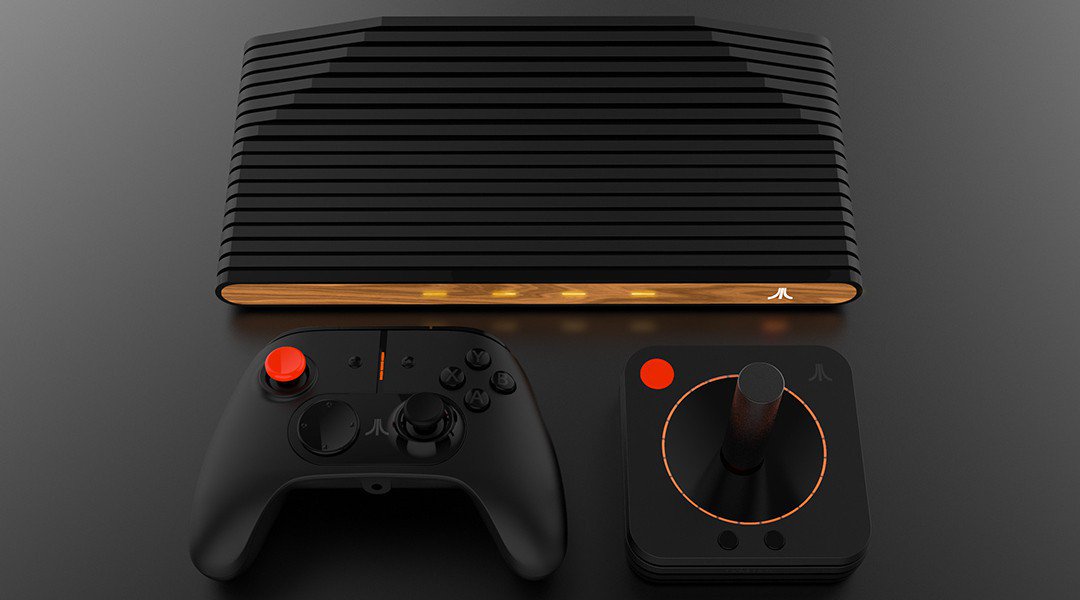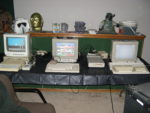What’s old is new again. This time it’s the Atari VCS, a new game console aimed directly at the nostalgic hearts of those of us who grew up in the late 70s and early 80s playing the Atari 2600. If you’re wondering what the Atari VCS is, what it does, how it compares to the Atari Flashback, and whether or not it’s worth buying, read on.
Those who were there (and any retrogamer worth their weight in buried E.T. cartridges) knows that Atari’s original console released back in 1977 was also known as the Atari VCS. It wasn’t until the release of the Atari 5200 that the original system was renamed the Atari 2600. For the remainder of this post, I’ll refer to the original console as the Atari 2600, and the modern revisioning as the Atari VCS.
Also, I should get this out of the way — Atari, the company, isn’t really “Atari”, the company. The original Atari, the one founded by Nolan Bushnell and Ted Dabney in the 1970s, hasn’t existed for a long, long time. In the early 80s, Atari split into two companies: one for software and game development (Atari Games Inc.), and one for hardware (Atari Corporation), which was sold to Jack Tramiel. Since then, Atari was purchased by JT Storage, JT Storage was purchased by Hasbro, and Hasbro was purchased by the French company Infogrames Entertainment. The only difference between the modern company calling itself Atari and any other hardware or software developer is that Atari purchased the rights to use the company’s logo.
In the summer of 2017, rumors of a new “Atari” (I’ll drop the snarky quotation marks hereon out) console began to hit the internet. After more than a year of rumors and computer renderings, Atari has finally released the specs of their new console, the (new) Atari VCS.

According to the Indiegogo launch page, the Atari VCS is a Linux computer (running Ubuntu) with 4GB of RAM and 32GB of storage. It supports Bluetooth and USB controllers, HDMI video, and comes with Atari Vault pre-installed. The pre-sale collector’s edition comes with two controllers and a system for $299.
There’s a lot to unpack in that paragraph.
The Indiegogo video shows the Atari VCS playing vintage Atari 2600 games, and with hardware specs like that, it should be able to with no problems. The Indiegogo page specifically mentions that the console ships with Atari Vault. Atari Vault is a collection of Atari games (mostly 2600 games, with a few arcade ports thrown in) that has been on sale for a few years. Atari Vault was released for Microsoft Windows, Linux, and macOS in 2016, and is available on Steam for $9.99. If you are planning to purchase the Atari VCS solely for the purpose of playing vintage Atari 2600 games, know that you can do that right now on your computer for a ten-spot.
(Atari emulation is nothing new. I have Atari emulators on all my computers, modded game console, and even my iPad.)
If the “living room experience” is important to you, don’t forget about the Atari Flashback system. The Atari Flashback 8 Gold (~$60 on eBay) contains 100+ Atari games, two joysticks, and HDMI out. It won’t offer some of the advanced features the Atari VCS is touting, but if all you want to do is play Atari 2600 games, this is a much more inexpensive plug-and-play option.
That’s not all the Atari VCS claims to be able to do, of course. The project’s launch page also mentions features like web browsing and video streaming, which, if it’s running Ubuntu Linux, make sense. Other than access to Atari’s new proprietary game library/store, everything that’s being advertised can be performed by a $35 Raspberry Pi computer, which also runs Linux. I have written several posts about the Raspberry Pi, and one specifically discussing RetroPie. Setting up a Raspberry Pi to play RetroPie is not as effortless as hooking up an Atari Flashback or (I’m assuming) a new Atari VCS. Setting up a Raspberry Pi takes some Linux knowledge and a bit of tinkering to get up and running. It’s not an out-of-the-box solution by any means. That being said, if you’re like me and have set up a $35 machine that can play essentially every Atari, Nintendo, Super Nintendo, and Sega Genesis game (along with hundreds of thousands of titles on other console and computer platforms), the idea of paying $299 for a console that does the same (or less) doesn’t excite me.
The Atari VCS Indiegogo page mentions their partners and online store without divulging many details. Roughly two-dozen confirmed partners are listed on the page. There are a lot of references like “we hope the new Atari VCS will inspire even more creativity!” along with lots of “we plan to” and “we intend to” that make me nervous. What makes me most nervous is that the plan sounds just like Ouya’s business model. The Ouya was a similar Android-based console released a couple of years ago. It too ran emulators and offered an online store, but failed when neither the chicken nor the egg materialized. Developers stopped making games for the system when people stopped buying games for the system because nobody was developing new games. The Puya launched in 2013 and was dead by 2015.
Here is my current biggest problem with the Atari VCS.
Payments made to Indiegogo are not guaranteed presales. The company says so, underlined and in bold on their own site that “Indiegogo is unable to guarantee that projects will succeed or that perks will be delivered or deemed satisfactory.” Even if Atari has the best of intentions and fully plans to deliver the new Atari VCS a year from now in the spring/summer of 2019, there is no guarantee when or if you will receive one. Payments on Indiegogo are early investments in a product or a dream. Even if I were inclined to spend $300 on an (in my opinion) overpriced Linux machine, I certainly wouldn’t do it through Indiegogo, and I most certainly wouldn’t do it a year prior to launch.
When Nintendo announced their NES Classic Edition, I predicted that there would be no market for the limited console and that it would be a big flop. I was wrong. The console sold out almost immediately and has been in high demand ever since, despite a long list of cheaper and better alternatives. I’d like to say the same for the Atari VCS, an expensive Linux machine, but through Indiegogo people have already invested $2.5 million in the past week. For their sake, I hope Atari comes through and delivers a gaming experience worthy of the price tag. For that matter, I hope Atari delivers anything at all.



































